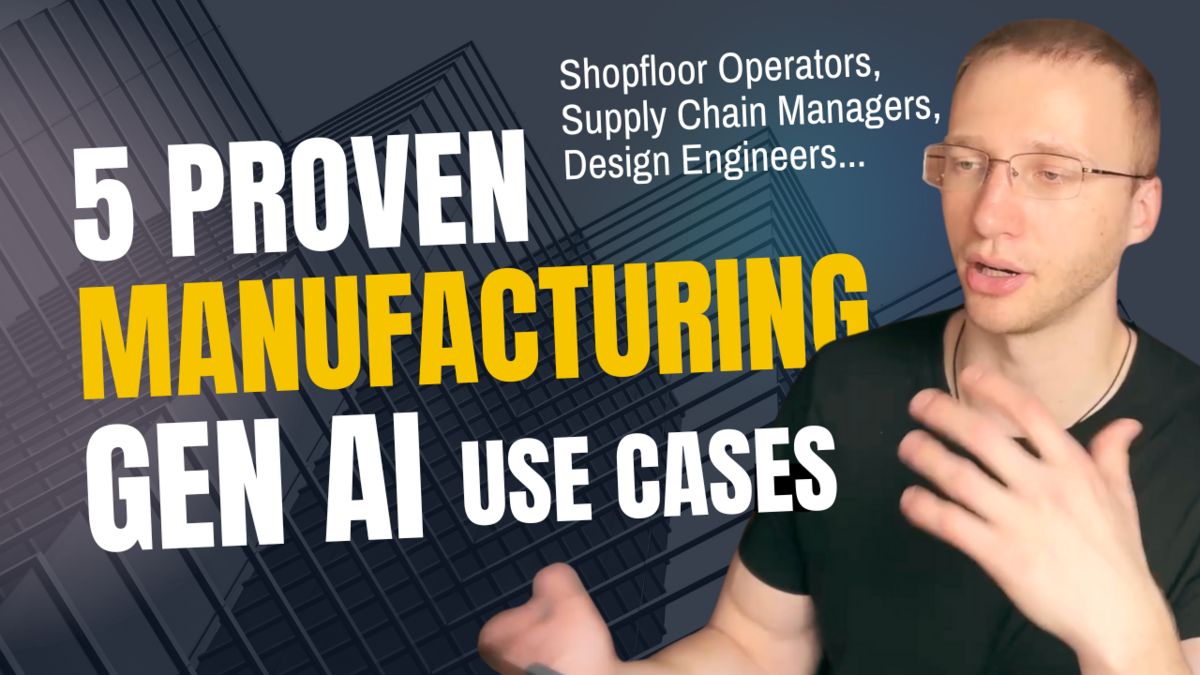Manufacturing is a fast-moving game. When one machine stalls or a supplier falls short, the entire operation feels the ripple effect. This is where Generative AI steps in - offering near-instant insights, suggested fixes, and data-driven decision-making that can trim costs, speed up production, and reduce headaches.
In this post, we’ll explore five key ways Generative AI is quietly transforming the manufacturing world, role by role.
Accompanying Video:
Download the PDF Report HERE
1. The Shop Floor Technician’s Co-Pilot
When a production line goes down, every second counts. Typically, a technician pulls out a hefty manual, scans through pages of error codes, and hopes to interpret cryptic instructions written in technical English. If English isn’t their first language, the struggle is even bigger.
Imagine handing them an AI “co-pilot” that’s been fed every manual, document, and fix-it note your factory has collected over the years. The moment they spot an error code—like a mysterious “CP65 thermal error”—they can ask the co-pilot what it means and how to fix it. If they need a translation? No problem. It can provide instructions in Spanish, Chinese, or whichever language fits the workforce.
Core Benefit: Downtime drops from hours to minutes, especially for less experienced operators. Production keeps rolling, and the factory gains a shared knowledge hub that doesn’t rely on one or two senior experts.
Potential Pitfalls:
• Controlling who can see chat logs to ensure privacy and keep morale high.
• Balancing ease of use: a tool is only effective if your operators actually want to use it.
• Compliance: meeting data privacy standards (like GDPR) and deciding user access levels.
2. Procurement Officers: Smarter Sourcing
Your procurement team can spend days juggling spreadsheets, reading market reports, and emailing suppliers to lock in the best deals on raw materials. Even then, supply and demand can change overnight.
Enter an AI-driven procurement assistant. It can scan price trends, supplier stock levels, shipping timelines, and historical data—essentially “seeing” across multiple systems in seconds. When a buyer asks, “When should we purchase capacitors for the next quarter?” they get immediate, well-grounded data and market insights.
Core Benefit: Less time crunching numbers, more time making strategic decisions. Procurement teams can quickly pivot if certain materials spike in price or slip out of stock.
3. Supply Chain Managers: Real-Time Updates
Natural disasters or regional disruptions can throw entire supply chains off balance. Normally, you’d piece together scattered data from emails, phone calls, or an ERP system, then spend hours puzzling out Plan B.
A supply chain co-pilot goes straight to the heart of the matter, pulling real-time shipping reports and forecasts into one place. When a hurricane hits a supplier’s region, the AI flags it, outlines how stock will be affected, and suggests nearby alternatives—plus any risk alerts for the upcoming weeks.
Core Benefit: Instantly see what’s going wrong (or right), how it affects production, and which steps to take next. Your entire team gains a dynamic, up-to-date view of orders, potential disruptions, and alternative strategies.
4. Quality Inspectors: On-The-Spot Insights
Quality inspectors act as the last line of defense. If they spot a warped board or out-of-spec part, they typically measure it, scribble notes, check a log, or call a supervisor to decode the problem. Production lines might halt as everyone scrambles to diagnose the issue.
Picture an AI co-pilot that knows your factory’s entire quality history. When a defect shows up, the inspector asks a simple question: “We’re seeing Warpage 123—what’s the likely cause?” The AI references known fixes, logs, and even potential improvement methods from past incidents.
Core Benefit: Faster fixes, deeper context, and a more standardized approach to defect handling. Production keeps flowing without relying on a single “go-to” person who might be juggling multiple tasks.
5. Design Engineers: Tapping Into Tribal Knowledge
When designing a new product or part, engineers often dig through archives or chat with seasoned colleagues, hoping to unearth a solution from years past. Even with solid documentation, a key insight from 2018 might slip through the cracks.
A design co-pilot can be fed every old project file, design iteration, and post-mortem your company has ever generated. If someone asks, “How did we lighten the battery case last time?” the AI instantly presents the relevant approach—like a rib design that cut weight by 10% and reduced defects by 15%. Instead of reinventing the wheel, your team builds on proven success.
Core Benefit: Designs improve faster, production cycles shorten, and your best lessons don’t get lost in the shuffle.
Parting Thoughts
The future of manufacturing isn’t about mindless automation or trying to replace humans with bots. It’s about empowering skilled professionals with information that’s always up to date, context-aware, and instantly available. From the moment a machine throws an error code to the day a new product rolls out, Generative AI co-pilots can cut downtime, slash costs, and help your team make more confident decisions.
Real impact comes from blending AI’s ability to handle massive data with the instincts of frontline workers, engineers, and supply chain pros. The result? A smoother, smarter operation that keeps everyone in the loop—and your products rolling off the line.
Stay curious, explore what’s possible, and keep an open mind to how these digital tools can level up your day-to-day. If you’re ready to dive deeper into the practical side of AI implementation and evaluation for manufacturing, you’ll find additional resources linked below:
